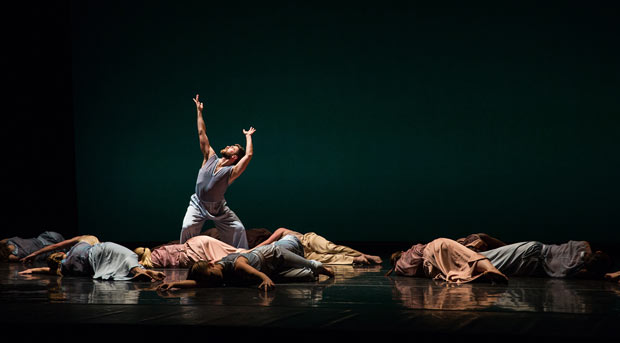
© Mat Hayward. (Click image for larger version)
Mark Morris Dance Group
Cargo, A Forest, Foursome, The
★★★✰✰
Brooklyn, Mark Morris Dance Center
17 May 2016
markmorrisdancegroup.org
Friends and Family
Every few years the Mark Morris Dance Group presents an evening of dances at the company’s Brooklyn headquarters, a nondescript brick building across from BAM. There’s a black box theater on the fifth floor with room for 140 seats. Watching dance there feels almost like going to a school play. The setting is informal and relaxed; you can see the dancers bumping into each other in the wings.
You experience choreography differently in such a setting. Some things – like clarity and a sense of the “big picture” – are lost, and others gained. You become keenly aware of the dancers’ bodies: how distinct they are, how many shapes and sizes they come in. And what they sound like when they slap their thigh or stomp out rhythms on the floor. The dancers’ faces leave a powerful impression. They look less like a company than like a group of individuals. (In that, it’s truer to Morris’s origins.)
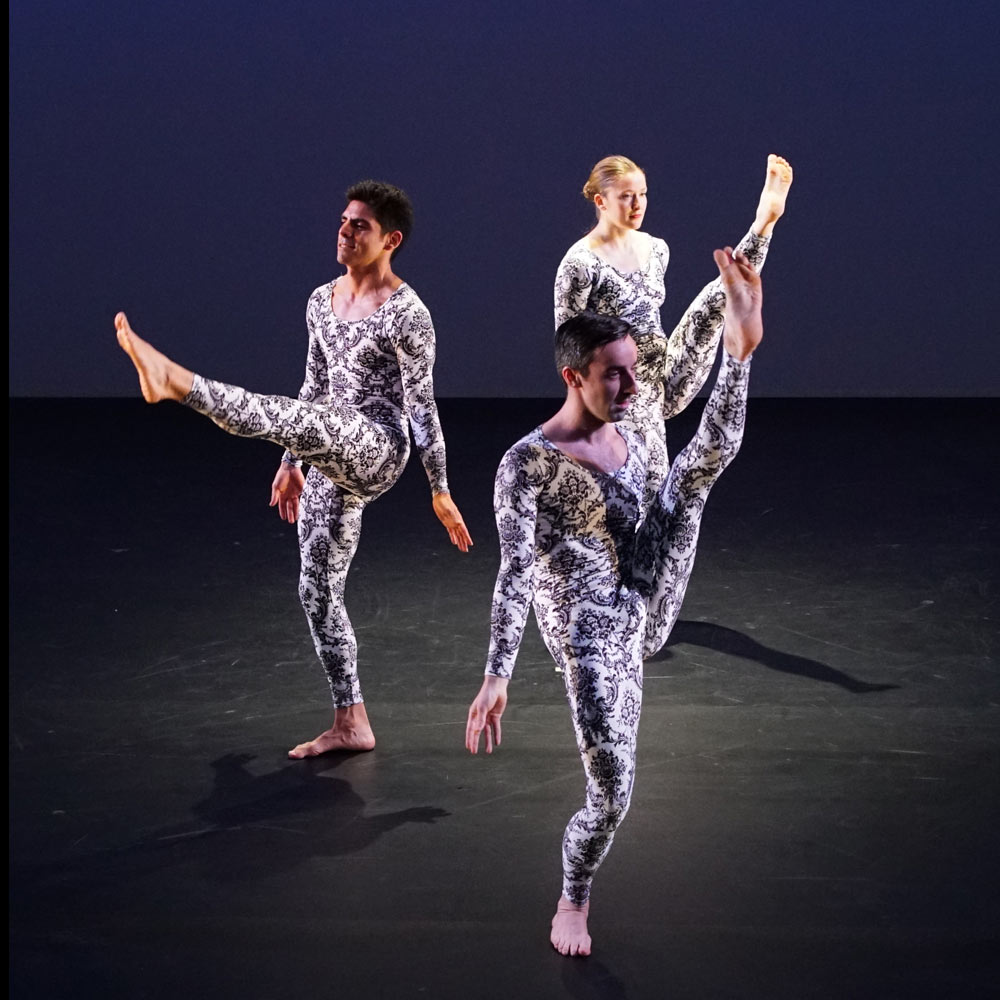
© Ani Collier. (Click image for larger version)
This week, the company is performing four works, three of them relatively recent, and one brand new. The new piece, A Forest, is set to a spare, transparent Haydn Trio (No. 44), played by Morris’s excellent musicians. (All the music is played live, led by the versatile Colin Fowler on the piano.) The title comes from a particular image at the start, in which the dancers stretch out their arms and fingers overhead, like the branches of a tree. The work has all the Morris hallmarks, hyper-precise musicality, recurring motifs, clever configurations, and a meticulous sense of rhythm. Morris responds to the trio’s classical structure, the voices of the instruments responding to each other, as well as the quality of the sound: stately chords are shown with big, lush pliés, delicate staccato figures with mincing steps or refined gestures. A trill becomes a shake of the legs, a staccato note a tap of the toe. Every repetition is clearly re-stated. But A Forest isn’t one of Morris’s inspired pieces; it’s rigorously and intelligently constructed, but doesn’t contain much in the way of surprise. (The costumes by Maile Okamura, unitards decorated with what looks like an 18th century wallpaper design, are unisex and funny, but not particularly flattering.)
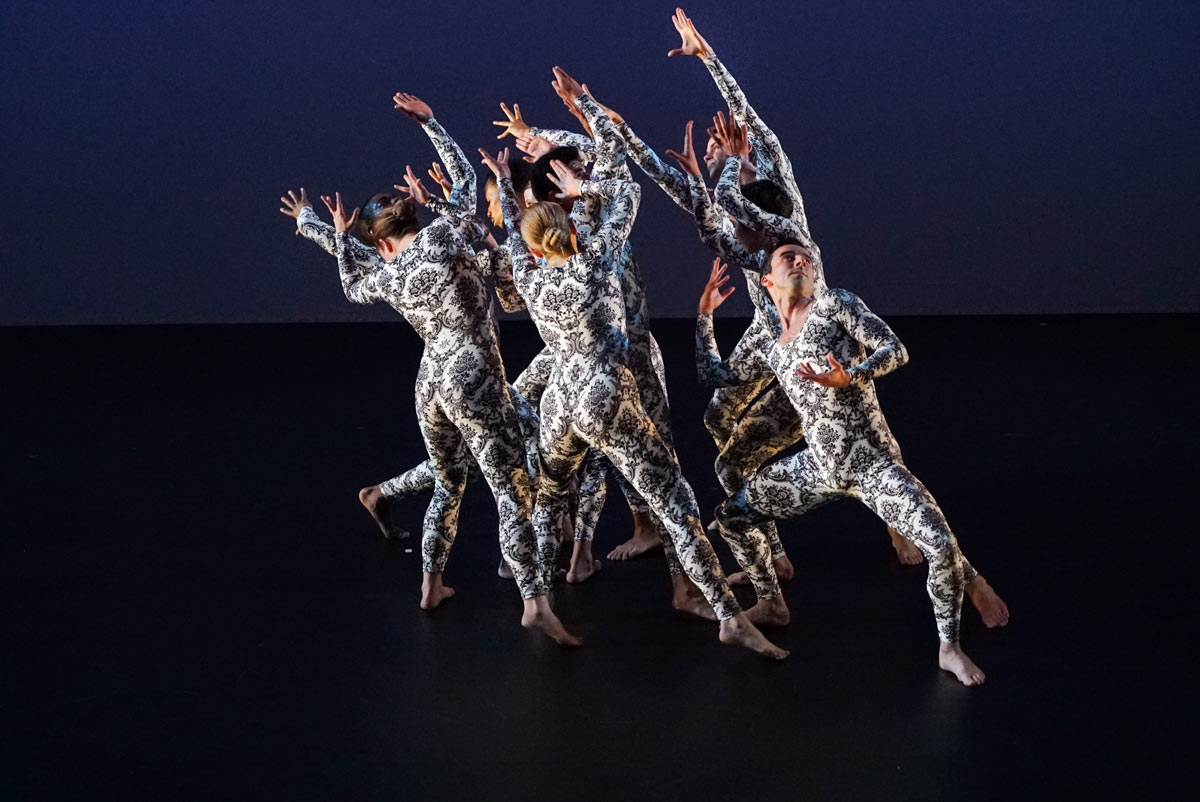
© Ani Collier. (Click image for larger version)
In this program, A Forest comes after Cargo, a curious work from 2005 in which Morris toys with primitivist movement and props: three sticks, which the local fauna treat like magical totems from another world. They tap them, they sniff them, they drop them and eventually they begin to use them. Wearing only plain white underwear, they dangle from the poles in various shapes, as if being carried off to be boiled for dinner. Or they lie under them, placing their hands on the poles in fluttering patterns. The music is Darius Milhaud’s La Création du Monde, played in a reduced version for five musicians. Its jazzy rhythms are reflected in syncopated jumps and raggedy movements for the dancers’ arms and back. In a recurring motif, two dancers carry a stick on their shoulders, walking in profile on bent legs, bumping their pelvises forward and back to the beat. As a novelty piece, it works well, but it’s not much more than that.
The best was saved for the second half. Foursome, a touching little dance for four men set to a surprisingly harmonious combination of Satie (three Gnossiennes) and Johann Nepomuk Hummel (Seven Hungarian Dances), is the kind of Morris piece that makes something extraordinary out of almost nothing. The guys wear everyday clothes and street shoes. As the first Gnossienne begins, they do little more than walk, pivot and open one arm, following it with their eyes. (Sitting this close, you can really appreciate how much Morris’s dancers do with their eyes.) The meditative Satie pieces alternate with Hummel’s Hungarian dances, with choreography built out of distilled folk movements: tilts and line dances, stomps, bows, hand flourishes. (Morris knows this style inside and out, having been an avid folk-dancer in his early Seattle days.) The dancers’ demeanor is open, polite. Each of the four – Domingo Estrada, Dallas McMurray, Billy Smith and Noah Vinson – has his own “flavor”. Smith is innocent and lyrical, Vinson cheeky, McMurray serious, Estrada warm and slightly amused. It’s a perfect dance for this space.

© Mat Hayward. (Click image for larger version)
The final work, The, is, in contrast, the least ideal for such close quarters, because of its size. There are sixteen dancers in all. (It was originally made for the Tanglewood Music Festival.) Again, it is set for a modified version of a larger score, Bach’s First Brandenburg Concerto, played here in a version for four hands, arranged by Max Reger. Colin Fowler and George Shevtsov were at the piano. Despite the close quarters, though, it’s clear that it’s a lovely piece, full of pleasing patterns and light, ballet-inflected footwork. The costumes, by Elizabeth Kirtzman, are unisex silk pajamas that flutter and billow with the dancers’ movements. The begins with glissades, a little jump that skims the floor, executed with the arms out, which makes the dancers look like they’re being lifted off the ground by a gust of wind. In the second movement, all but one of the dancers lie on the floor doing an arm dance, while one man (Sam Black) performs a slow solo above them, like a tree bending over a field of reeds. Then they all rise up together, like a chain of dominos in reverse. Later, a theme emerges: a fist raised up to the sky, a victorious gesture that binds the dancers together in some unknown noble cause. There are marches, happy dances, ballroom duets, wrapped up by explosions of movement for the whole ensemble.
The is one of Morris’s grand statements, a work in which the dancers, all equal in skill, join in a larger effort, a model for human co-existence. Now, if we could only see it on a larger stage…









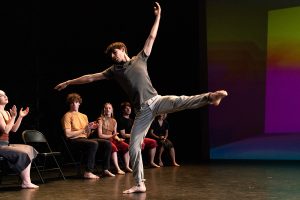

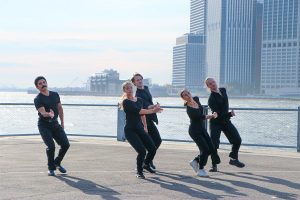


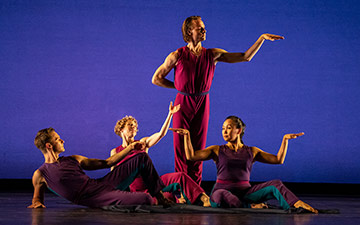


You must be logged in to post a comment.